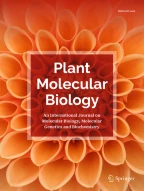Abstract
Substantial concentrations of NH4 + are found in the apoplast of the leaves of Brassica napus. Physiological studies on isolated mesophyll protoplasts with 15NH4 + revealed the presence of a high-affinity ammonium transporter that shared physiological similarity to the high-affinity NH4 + transporters in Arabidopsis thaliana (AtAMT1;3). PCR techniques were used to isolate a full-length clone of a B. napus homologue of AMT1 from shoot mRNA which showed 97% similarity to AtAMT1;3. The full-length cDNA when cloned into the yeast expression vector pFL61 was able to complement a yeast mutant unable to grow on media with NH4 + as the sole nitrogen source. Regulatory studies with detached leaves revealed a stimulation of both NH4 + uptake and expression of mRNA when the leaves were supplied with increasing concentrations of NH4 +. Withdrawal of NH4 + supply for up to 96 h had little effect on mRNA expression or NH4 + uptake; however, plants grown continuously at high NH4 + levels exhibited decreased mRNA expression. BnAMT1;2mRNA expression was highest when NH4 + was supplied directly to the leaf and lowest when either glutamine or glutamate was supplied to the leaves, which directly paralleled chloroplastic glutamine synthetase (GS2) activity in the same leaves. These results provide tentative evidence that BnAMT1;2may be regulated by similar mechanisms to GS2 in leaves.
Similar content being viewed by others
References
Cowling, D.W. and Lockyer, D.W. 1981. Increased growth of ryegrass exposed to ammonia. Nature 292: 337–338.
Finnemann, J. and Schjoerring, J.K. 1999. Translocation of NH 4+ in oilseed rape plants in relation to glutamine synthetase isogene expression and activity. Physiol. Plant. 105: 469–477.
Frommer, W.B., Hummel, S. and Riesmeier, J.W. 1993. Expression cloning in yeast of a cDNA encoding a broad specificity amino acid permease from Arabidopsis thaliana. Proc. Natl. Acad. Sci. USA 90: 5944–5948.
Gazzarrini, S., Lejay, L., Gojon, A., Ninnemann, O., Frommer, W.B. and von Wiren, N. 1999. Three functional transporters for constitutive, diurnally regulated, and starvation-induced uptake of ammonium into Arabidopsis roots. Plant Cell 11: 937–947.
Hsieh, M.-H., Lam, H.-M., van de Loo, F.J. and Coruzzi, G. 1998. A PII-like protein in Arabidopsis: putative role in nitrogen sensing. Proc. Natl. Acad. Sci. USA 95: 13965–13970.
Husted, S., Hebbern, C.A., Mattsson, M. and Schjoerring, J.K. 2000. A critical experimental evaluation of methods for determination of NH 4+ in plant tissue, xylem sap and apoplastic fluid. Physiol. Plant. 109: 167–179.
Kleiner, D. 1985. Bacterial ammonium transport. FEMS Microbiol. Rev. 32: 87–100.
Lauter, F.R., Ninnemann, O., Bucher, M., Riesmeier, J. and Frommer, W.B. 1996. Preferential expression of an ammonium transporter and two putative nitrate transporters in root hairs of tomato. Proc. Natl. Acad. Sci. USA. 93: 8139–8144.
Lorenz, M.C. and Heitman, J. 1998. The Mep2 ammonium permease regulates pseudohyphal differentiation in Saccharomyces cerevisiae. EMBO J. 17: 1236–1247.
Marini, A.-M., Soussi-Boudekou, S., Vissers, S. and Andre, B. 1997. A family of ammonium transporters in Saccharomyces cerevisiae. Mol. Cell. Biol. 17: 4282–4293.
Michel-Reydellet, N., Desnoues, N., de Zamaroczy, M., Elmerich, C. and Kaminski, P.A. 1998. Characterization of the glnK-amtB operon and the involvement of AmtB in methyl ammonium uptake in Azorhizobium caulinodans. Mol. Gen. Genet. 258: 671–677.
Nielsen, K.H. and Schjoerring, J.K. 1998. Regulation of apoplastic ammonium concentration in leaves of oilseed rape. Plant Physiol. 118: 1361–1368.
Ninnemann, O., Jauniaux, J.-C. and Frommer, W.B. 1994. Identification of a high affinity NH 4+ transporter from plants. EMBO J. 13: 3464–3471.
Sohlenkamp, C., Shelden, M., Howitt, S. and Udvardi, M. 2000. Characterization of Arabidopsis AtAMT2, a novel ammonium transporter in plants. FEBS Lett. 467: 273–278.
Tsay, Y.F., Schroeder, J.I., Feldmann, A. and Crawford, N.M. 1993 The herbicide sensitivity gene CHL1 of Arabidopsis encodes a nitrate inducible nitrate transporter. Cell 72: 705–713.
von Wiren, N., Gazzarrini, S., Gojon, A. and Frommer, W.B. 2000a. The molecular physiology of ammonium uptake and retrieval. Curr. Opin. Plant Biol. 3: 254–261.
von Wiren, N., Lauter, F.-R., Ninnemann, O., Gillissen, B., Walch-Liu, P., Engels, C., Jost, W. and Frommer, W.B. 2000b. Differential regulation of three functional ammonium transporter genes by nitrogen in root hairs and by light in leaves of tomato. Plant J. 21: 167–175.
Wang, R.C. and Crawford, N.M. 1996. Genetic identification of a gene involved in constitutive, high affinity nitrate transport in higher plants. Proc. Natl. Acad. Sci. USA 93: 9297–9301.
Wang, M.Y., Siddiqi, Y., Ruth, T.J. and Glass, A.D.M. 1993a. Ammonium uptake by rice roots. I. Fluxes and subcellular distribution of 13NH 4+ . Plant Physiol. 103: 1249–1258.
Wang, M.Y., Siddiqi, Y., Ruth, T.J. and Glass, A.D.M. 1993b. Ammonium uptake by rice roots. II. Kinetics of 13NH 4+ influx across the plasmalemma. Plant Physiol. 103: 1259–1267.
Wang, M.Y., Glass, A.D.M., Shaff, J.E. and Kochian, L.V. 1994. Ammonium uptake by rice roots. III. Electrophysiology. Plant Physiol. 104: 899–896.
Author information
Authors and Affiliations
Rights and permissions
About this article
Cite this article
Pearson, J., Finnemann, J. & Schjoerring, J. Regulation of the high-affinity ammonium transporter (BnAMT1;2) in the leaves of Brassica napus by nitrogen status. Plant Mol Biol 49, 483–490 (2002). https://doi.org/10.1023/A:1015549115471
Issue Date:
DOI: https://doi.org/10.1023/A:1015549115471
